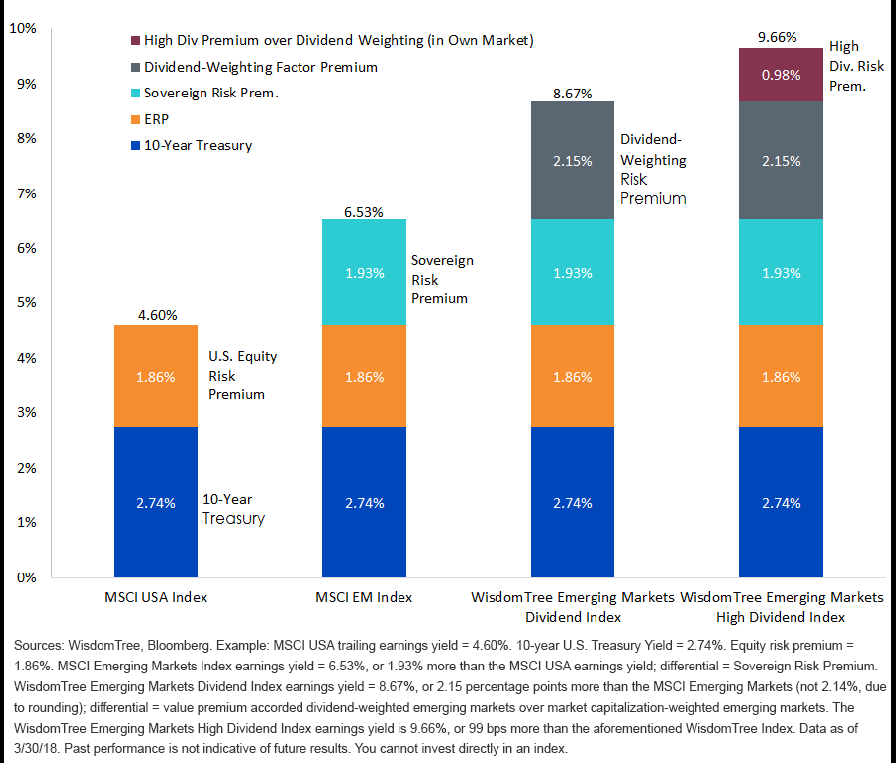DVEM & DEM: There Are Still Inexpensive Equity Markets


The headwinds for value investing over the last decade have been formidable. Ever since the post-Lehman recovery commenced nearly nine years ago, markets have been led by U.S. growth stocks, with emerging markets largely lagging until 2017. Among emerging markets, value stocks had an even tougher run. Opportunity may loom in the WisdomTree Emerging Markets Dividend Fund (DVEM) and the WisdomTree Emerging Markets High Dividend Fund (DEM), two of our ETFs that track broad emerging market exposures with an emphasis on dividend payers.
Subscribers to a mean reversion school of thought might take note of sharp performance disparities. In 2017 alone, the MSCI Emerging Markets Growth Index returned 46.8%, handily outperforming its value counterpart, the MSCI Emerging Markets Value Index (+28.1%).1
Go back longer: In emerging markets, the cumulative return differential between growth and value in the last five years has been 3,032 basis point (bps).2 The contrast with U.S. equity markets is starker. Whereas broad emerging markets returned 4.6% annually over the last five years and emerging value registered 1.7% gains, the S&P 500 chalked up 16.2% a year.3 These are “bull market problems,” but they are still problems. Emerging market value stocks are clear laggards.
DVEM and DEM, our dividend-weighted emerging equity ETFs whose underlying Indexes yield 3.89% and 5.24%, respectively,4 offer a chance to look at the asset class as a value investor. After all these years in the cold, emerging value’s appealing fundamentals are striking given the bull market’s age, as seen in the next section.
Stacking Risk Premiums
On the bar first from the left in figure 1, we see the MSCI USA Index’s 4.60% earnings yield (the reciprocal of the price-to-earnings [P/E] ratio), which is 186 bps more than the 2.74% yield on 10-year Treasuries. That equity risk premium (ERP) has been dwindling with each stock market uptick.
Next to that is the 6.53% earnings yield on the MSCI Emerging Markets Index, giving emerging markets a 1.93% sovereign risk premium over U.S. equities. That is a sizeable amount of compensation.
Aswath Damodaran, professor of finance at New York University,2 theorizes that a market’s equity risk premium should equal that of an established market plus an extra spread that accounts for that nation’s volatility-weighted default risk premium. For example, if the U.S. has an ERP of 3% and another country has a volatility-adjusted default risk premium of 1.20%, its equity risk premium over U.S. Treasuries would be 3% + 1.20%, or 4.20%.
We already determined that the U.S. ERP is 1.86%. Looking at five-year USD credit default swaps for Brazil, Russia, India and China (the BRICs) to get a feel for the emerging market credit environment in some major countries, we find volatility-adjusted default risk premiums of 185 bps, 136 bps, 83 bps and 69 bps, respectively.6 Those figures suggest that the MSCI Emerging Markets Index’s 190 bps of extra earnings yield over U.S. equities may be generous.
Figure 1: Components of Earnings Yield

Moving rightward, the WisdomTree Emerging Markets Dividend Index, which is tracked by DVEM before fees and expenses, has an earnings yield that is 215 bps higher than that, at 8.67%. The WisdomTree Index’s earnings yield is thus nearly double that of U.S. equities. Finally, and intriguingly, if we take it one step over to DEM’s underlying Index, the WisdomTree Emerging Markets High Dividend Index, we arrive at an earnings yield that is pushing 10%, another 98 bps over and above DVEM’s tracking Index.
In P/E terms, the WisdomTree Emerging Markets Dividend Index is trading for 11.5 times earnings, 24.7% lower than the MSCI EM Index. Its high-dividend counterpart, tracked by DEM, is valued at 10.4 times trailing earnings. For context, MSCI USA is at 21.7 times earnings.7 The WisdomTree ETFs are broad too, with DVEM covering nearly 700 companies and DEM capturing more than 300. With these ETFs’ underlying Indexes offering dividend yields in the mid-3% and 5% area, investors also get a buffer over and above the 2.43% and 1.98% yields of the MSCI Emerging Markets Index and the S&P 500, respectively.8
1Source: Bloomberg. Unless otherwise stated, all data in this report through or as of 12/29/17.
2Source: Bloomberg. Growth and value represented by the MSCI Emerging Markets Growth and MSCI Emerging Markets Value Indexes.
3Sources: MSCI, S&P, Bloomberg.
4Source: Bloomberg. Trailing 12-month dividend yield, as of 4/6/18.
5Damodaran Online, http://pages.stern.nyu.edu/~adamodar/.
65-year USD credit default swaps (CDS) for Brazil, Russia, India and China of 165 bps, 121 bps, 74 bps and 62 bps, respectively, multiplied by 1.12 to capture Damodaran’s 12% volatility adjustment between the volatility of sovereign bond spreads over U.S. Treasuries and emerging market equity risk. Data as of 4/6/18, from Bloomberg.
7Source: Bloomberg. Data as of 3/30/18.
8Source: Bloomberg. Trailing 12-month dividend yield, 4/6/18.


